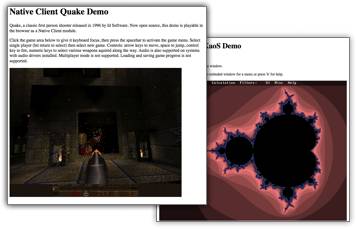Tuesday, December 9, 2008
Google Releases Browser Extension to Run Native Code

Google has released something to the open source world they call the Native Client. It is meant as a way for website developers to execute rich code faster within the browser... by having it run “natively” on the computer. This could help any program needing fast graphics; a web-based photo editor might be one of the use cases of this, Google explains. Right now, as a developer you’re usually picking Flash or Java for that purpose. Google describes their efforts:
At its core, our release consists of a runtime, a browser plugin, and a set of GCC-based [GNU Compiler Collection] compilation tools. Together, these components make it possible to build applications that run in a web browser but incorporate native code modules.
A closer connection to the computer yields more power, but it also brings with it the need for higher security considerations, as Google realizes:
To help protect users from malware and to maintain portability, we have defined strict rules for valid modules. At a high level, these rules specify 1) that all modules meet a set of structural criteria that make it possible to reliably disassemble them into instructions and 2) that modules may not contain certain instruction sequences. This framework aims to enable our runtime to detect and prevent potentially dangerous code from running and spreading. We realize that making this technology safe is a considerable challenge. That’s why we are open sourcing it at an early stage: we believe that peer review, community feedback, and public scrutiny greatly improve the quality of security technologies like this one.
To get started, if you’re brave you can download and install the ≈88MB Native Client. It’s all a very early release for now and the installation is aimed at developers, not so much end users yet; for instance, you need Python to run the installation scripts. After installation you can give Google’s demos like Quake a try (Quake is a 3D ego-shooter which is now open sourced itself, and can thus be used for such demos).
Other efforts by Google to boost up the web framework – which helps their own apps too of course – are their browser plug-in Google Gears, their browser Chrome, and arguably also their financial support of the foundation behind the Firefox browser. But every company has a different answer to just which boost is needed. Microsoft’s answer, for instance, was a project called Silverlight, and once the introduction of the option to run ActiveX controls inside Internet Explorer. If any company manages to successfully widely deploy their idea of the best extension, that company will start to hold even more power over the web, because it can influence the web’s direction without taking the long route through standards bodies like the World Wide Web Consortium.
[Thanks Juha-Matti Laurio! Screenshots by Google.]
>> More posts
Advertisement
This site unofficially covers Google™ and more with some rights reserved. Join our forum!
